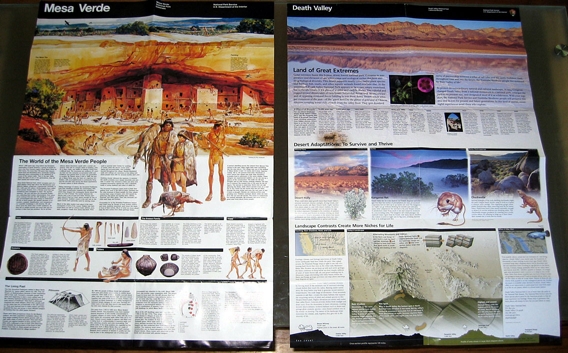« The Single Prettiest Picture From The Road Trip | Main | Designing for People - Introduction and Initial Thoughts »
January 04, 2004
Your Tax Dollars Delivering Good Design
When one thinks of good graphic design, one pretty much never thinks about the work of the federal government. American graphic designers have long bemoaned the government's lack of interest in supporting good design (and always always always hold up the Netherlands as the ideal).
I spent 10 days over the holidays on a road trip throughout the American Southwest, with the chief destinations being national parks -- Death Valley, Grand Canyon, Mesa Verde, Canyon de Chelly, and Petrified Forest. Perhaps in another post, I'll discuss the travels. Here, I'm focusing on something else.
Upon entry of each park, you receive a park brochure. Overtime, you realize there's a pattern to the brochures -- black band across the top with white type, and lush imagery to draw your attention.
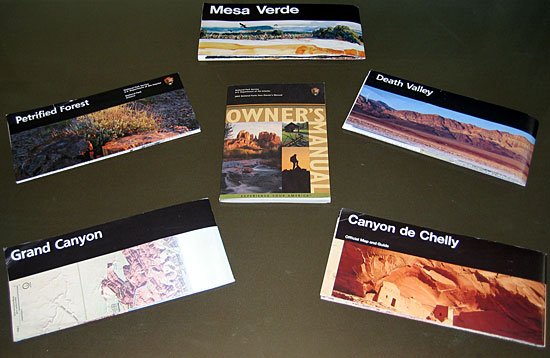
So, already, we're seeing the development of a smart graphic system -- bold, striking, clear, and engaging. There's not a visitor to a national park who doesn't want to immediately open the brochure to see what goodies await them, and the brochures rarely fail to deliver.
The Mesa Verde brochure serves as something of a standard bearer for publication design, so we'll focus on that. When you first open the brochure, the imagery continues, depicting life when Mesa Verde was inhabited (this is a departure from the other brochures, that utilize photographs):
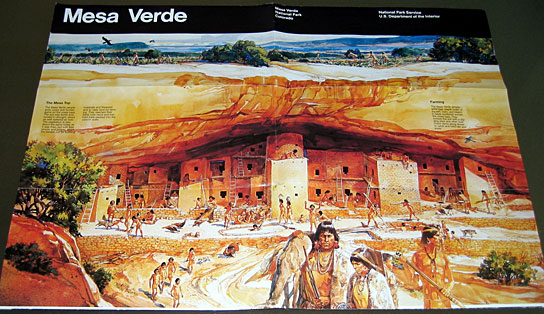
As you continue to open it fully you are given textual information explaining the park.
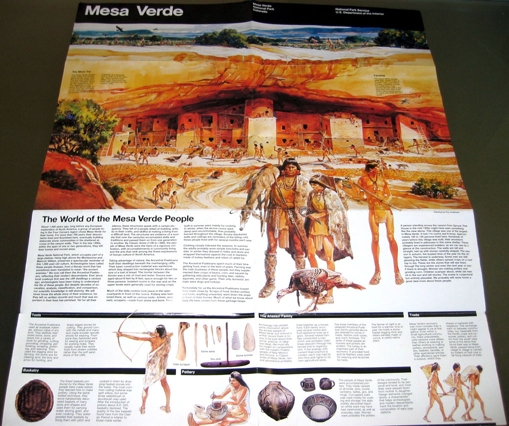
(Click the image for an enlarged view)
Stacy was the Keeper of the Brochures (I tended to be the driver), and what she noticed pretty soon is how the information on the brochure is aligned with the large page's folds. So, if you can't have the whole thing open in front of you, you could choose to expose the text:
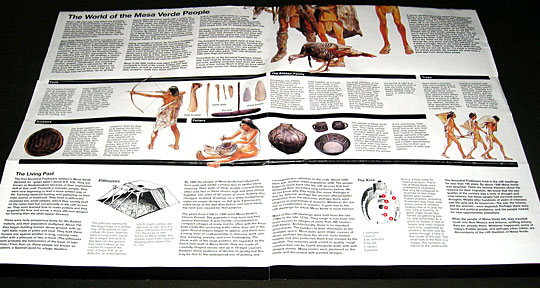
And the same goes for the back side. You can see where the fold separates the text from the map:
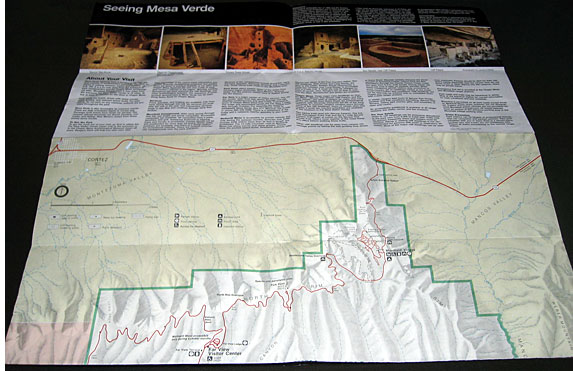
Obviously, this isn't happenstance. It's a precise plan, and a remarkably aware one. While I was pleased to see a government agency capitalize on graphic identity standards such as the black bar and the imagery, I was surprised to realize that a government agency used a design system that afforded greater utility.
It turns out there's a very good reason for this, which a wee bit of web digging unearthed.
The National Park Service's Department of Publications has their shit together. As someone who labors to get clients to understand the value of smart, consistent design, I was delighted to click around the Publications mini-site, and see how they communicate their mission and operations.
If you click into the brochures section you see a link to "The Unigrid System", created by Massimo Vignelli back in 1979, and still used to support good design.
I also love the section on the process by which publications are developed.
If you look at a variety of brochures, you realize that just because they're based on the same grid system (and have other requirements for color, typography, and imagery) that it doesn't mean a designer's creativity is impinged. Look at the Mesa Verde and Death Valley brochures side-by-side:
The Death Valley brochure is newer, utlizing color photographs as screened-out backgrounds, and playing with the grid a bit to provide a different experience. But it still basically works along the folds, and it's clear that it's a cousin to the Mesa Verde display.
The National Park Service faces a monumental task. How do they keep their hundreds of sites in line when it comes to a standard look and feel? Their website shows you how they attempt to manage it. The results are not perfect -- across brochures you'll see inconsistent typography, or just plain mediocre design (I'm looking at you, Grand Canyon) -- but considering the scope of the problem, they perform more than admirably.
And it's clear that they're willing to have some fun. Typically, at the bottom of a brochure is a black bar. For Death Valley, they let the designers play with that element to communicate some valuable information:
Kudos to the National Park Service for providing us an example of a government agency that isn't afraid of innovative design.
Posted by peterme at January 4, 2004 07:50 PM
Trackback Pings
TrackBack URL for this entry:
http://www.peterme.com/mt/mt-tb.cgi/252
Listed below are links to weblogs that reference Your Tax Dollars Delivering Good Design:
» US Park System Information Design from Brain Fuel for Web Designers
Peterme brings up a great topic: information design in the US Government... especially for our national park systems. He shows examples and provides some insight into how the maps and information hand outs are created.... [Read More]
Tracked on January 6, 2004 09:38 PM
» Future Friendly Design from How Now, Brownpau?
Peter Merholz on the National Park Service's brochure design. I'm currently working on an NPS-related project, and was a bit annoyed at a recent redesign... [Read More]
Tracked on January 7, 2004 10:24 PM
» Constant, partial, sorry what were you saying? from Blackbeltjones Work
Good overview of "absent presence" and other afflictions of modern technology, found via LMG:For years, researchers have discussed how cell... [Read More]
Tracked on January 22, 2004 09:23 AM
» Constant, partial, sorry what were you saying? from Blackbeltjones Work
Good overview of "absent presence" and other afflictions of modern technology, found via LMG:For years, researchers have discussed how cell... [Read More]
Tracked on January 22, 2004 09:26 AM
» A declaration of relaxation from Typescape
After seven months, it seems clear that I do not possess the drive or sense of urgency required to actually keep a worthwhile blog. Funny that, I happily put work into setting the damn thing up, but when it comes... [Read More]
Tracked on January 24, 2004 08:33 AM
» A declaration of relaxation from Typescape
After seven months, it seems clear that I do not possess the drive or sense of urgency required to actually keep a worthwhile blog. Funny that, I happily put work into setting the damn thing up, but when it comes... [Read More]
Tracked on January 24, 2004 08:37 AM
» peterme.com: Your Tax Dollars Delivering Good Design from Citizens Of Upright Moral Character
http://www.peterme.com/archives/000255.html
while researching brochure designs I came across this recent blog on the National Park Service. I've always liked their brochures. In fact I have a ton of them in my obsessive compulsive map collection. [Read More]
Tracked on February 13, 2004 10:54 AM
Comments
guessed Vignelli from the first photo. He also did the IRS tax forms and the entire NY system (in the 70's, but most of his work remains). Plus loads of big time logos and the like. For his entire career he's used only two fonts, Helvetica, and I think Bodoni for his serif. Great stuff working with self imposed limitations. Think it was the NYT Magazine that had a photo of designers desks a few years ago. Vignelli's was a big class conference style table, with absolutely nothing on it but a pen and pad. Quite a contrast to the creative messes of just about every other designer in the issue and that I've met...
Posted by: Abe at January 5, 2004 12:15 AM
The brochures are very nice. They remind me of illustrations from national geographic. The photos let the parks speak for themselves, the illustrations are also great. I work for a local government agency and can say that our graphics/illustration unit is underfunded but still produces some great work. Although, the majority of it is for in house display only.
Posted by: Tom at January 5, 2004 06:15 PM
I've been collecting these brochures for years. They are classy, extremely well designed, and extremely useful. They are the best souvenir you can acquire from a National Park.
Posted by: kiri at January 6, 2004 07:39 AM
@issue has a good overview of the Park Service communications design program.
Posted by: John at January 6, 2004 09:05 AM
Some government agencies seem to be becoming more aware of the value of desing. The post office has contracted Carnegie Mellon's School of Design for an elaborate bunch of work on manuals for um, how to use the post office. (press release)
I saw some of the process for this, and it had an awful lot to do with understanding how and where the information would be used.
Elsewhere, things continue to suck. Anyway, thanks a lot for the park brochure example. Nice.
Posted by: Marc at January 6, 2004 10:43 AM
Peter, great topic and excellent writing. I posted a link back here from BrainFuel.
Chris
Posted by: Chris at January 6, 2004 09:40 PM
These publications are always informative, and well done. It's inspiring and refreshing to know that good design can survive. Great discussion on this, Mr. Merholz.
Posted by: Marc at January 7, 2004 04:51 PM
I'm glad to hear your experience of these wonderfully-designed artifacts. Mullet and Sano discussed them as examples of good design in their book Designing Visual Interfaces.
Posted by: Jodi at January 11, 2004 03:29 PM
Thank you, I work for the National Parks Publications and your comments made our designers and editors smile. They work very hard and are great people to work with. We thought your comments to be darling, superior and wise.
Posted by: Teri at January 15, 2004 09:41 AM
Can anyone suggest a good way of displaying and preserving these brochures? I've collected quite a few of them, but haven't found a way to hold them. They're all just in a pile at the moment ... :-
Posted by: Matthew Lynn at January 19, 2004 08:59 AM
Too bad the links to the nps.gov site don't work anymore...
Posted by: C Sky at May 17, 2004 10:57 AM
So now I am to end it all, having written a smaller-size account for the information or the racing amusement of my pay day loans.
Posted by: faxless pay day loans at March 23, 2006 12:48 PM
